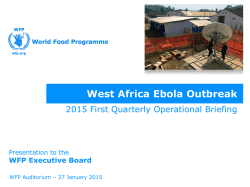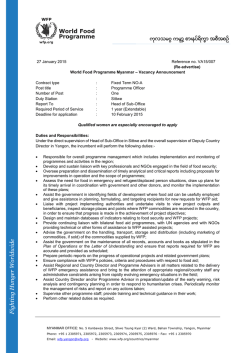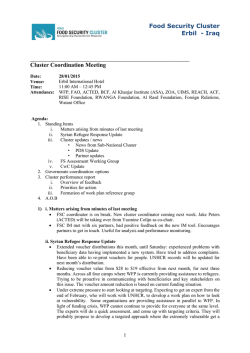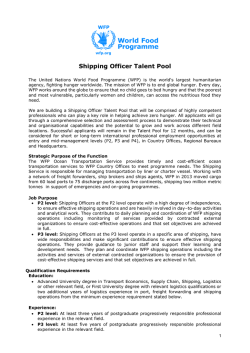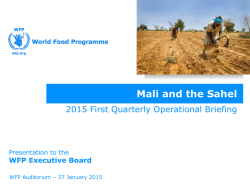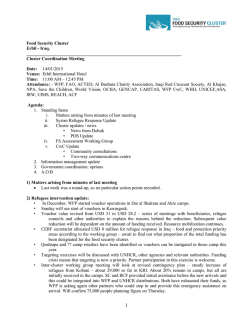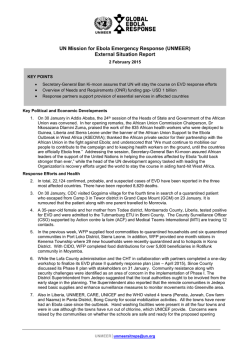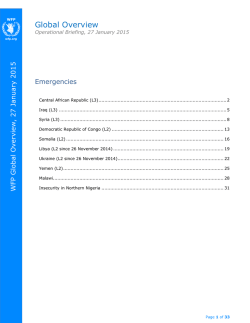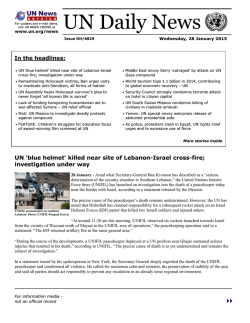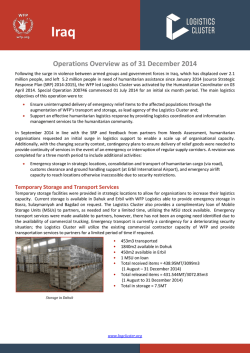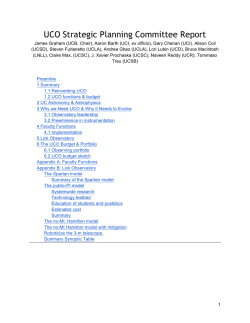
South Sudan - WFP Remote Access Secure Services
South Sudan 2015 First Quarterly Operational Briefing Presentation to the WFP Executive Board WFP Auditorium – 27 January 2015 SITUATIONAL UPDATE Humanitarian Situation • Over 1.9 million people have been displaced by the crisis that began in midDecember 2013. Of that, nearly 500,000 are refugees in neighbouring countries. (OCHA, December 2014) • Within South Sudan, about 1.4 million people are internally displaced. More than 100,000 of these are sheltering in UNMISS bases. • According to the latest IPC analysis from September 2014, 2.5 million people are projected to be in emergency and crisis phase (IPC phases 4 and 3) from January to March 2015. • Conflict-related displacement continues and due to the fluid security situation populations remain mobile; Security Situation SITUATIONAL UPDATE Background: • Several regional, peace-initiatives on going most notably the: – Arusha Process aims at reuniting the ruling Sudan Peoples Liberation Movement (SPLM) – Intergovernmental Authority on Development (IGAD) process; next round starts 30 January 2015. Current Situation: • Sporadic fighting continues in Upper Nile, northern Jonglei and Unity states; • Clashes have taken place around key river delivery routes; • Marked increase in community defence groups and local level militias; Impact: • Security situation remains fluid, populations remain mobile; • Harassment of humanitarian staff; • Access constraints, requiring negotiations with multiple armed actors Outlook: • Possible escalation of conflict as the dry season begins Situation map MAP WILL BE PROVIDED BY HQ OIM/GIS CLOSER TO TIME WITH UPDATED DATA Framework of Interventions EMOP 200659 – Emergency Operation in Response to Conflict in South Sudan PRRO 200572 – Food and Nutrition Assistance for Relief and Recovery, Supporting Transition and Enhancing Capabilities to Ensure Sustainable Hunger Solutions. SO 200778 – Logistics Cluster SO 200791– Emergency Telecommunications Cluster PROGRAMMING SO 200634 – UNHAS SO 200379 – Feeder Roads LICK TO EDIT SUBTITLE SO 200775 – Food Security Cluster Activities Total targeted beneficiaries for 2015 (EMOP and PRRO): 3.2 million • Emergency food assistance for internally displaced people and conflictaffected, severely food insecure residents (EMOP) • Blanket and targeted nutritional support to children and mothers (EMOP and PRRO) • Unconditional food transfers for refugees and Abyei displaced (PRRO) • Food for Education and Food Assistance for Assets (food and cash transfers) in states not directly affected by the conflict (PRRO) LICK TO EDIT SUBTITLE • PROGRAMMING Clusters and Common Services • • • • Food Security and Livelihoods (co-lead with FAO) Logistics Emergency Telecommunications UNHAS • Scale-up activities to provide life-saving food assistance to IDPs and conflictaffected communities; • Utilize the window of opportunity in the dry season to maximize surface transport and preposition (107,000 mt planned); • Establish permanent and semipermanent presence while remaining flexible to reach mobile populations in remote areas through Integrated Rapid Response Strategy (UNICEF and FAO main partners); • Enhance nutritional support to women and children under five, with UNICEF and NGOs; • Continue recovery activities planned under the PRRO and look for new opportunities to support early-recovery. LICK TO EDIT SUBTITLE PROGRAMMING Operational Priorities Sudan Corridor -50,466 Prepo - 16,000 2015 Prepo Plan KENYA/UGANDA Corridor -201,866 Prepo – 64,200 LICK TO EDIT SUBTITLE ETH/DJI Corridor - 84,111 Prepo - 26,800 Number of preposition locations 21 Number of expanded warehouses 12 Corridor Kenya/ Uganda 2015 needs (MT) Prepo (MT) 201,866 64,200 Ethiopia/ Djibouti 84,111 26,800 Sudan 50,466 16,000 Total 336,443 107,000 • Significant improvement has been made on the passage of humanitarian goods including WFP’s cargo, assets and staff, however delays continue to be experienced due to bureaucratic impediments. Air assets are not immune to delays and cancellations due to security concerns. Access must be negotiated constantly with parties of the conflict. • In-country food movements are hindered by deteriorated road conditions due to lack of maintenance and excessive flooding. • Four barge convoys, crossing multiple front-lines from Juba/Bor reached their final destinations. A fifth barge convoy has been loaded and is expected to move soon. WFP, under its Logistics Cluster responsibilities, is also going to conduct the first-barge movement for the humanitarian community at large. • Government of South Sudan and Sudan have agreed to an operational plan allowing the use of the Sudan corridor for humanitarian cargo by river, road and air. Two truck convoy and one barge convoy have so far crossed the border and reached its final destinations. LICK TO EDIT SUBTITLE ACCESS Access • Food Security Monitoring System data collection is being conducted and feeds into the IPC analysis • Distribution monitoring: WFP and partner staff are present during distributions • Post distribution monitoring: PDMs have been conducted at sites where the IDP population is more settled and security is guaranteed LICK TO EDIT SUBTITLE PROGRAMMING Monitoring Operational Requirements PLANNED 2015 BENEFICIARIES SIX-MONTH SHORTFALL (USD) EMOP 200659 (2015) 504 Million 1,500,000 $207 million PRRO 200572 (2015) 331 Million 1,700,000 $170 million SO 200786 (UNHAS) $59.3 million n/a $14 million SO 200778 (Logistics Cluster) $34.9 million n/a $17.5 million SO 200775 (Food Security) $1.37 million n/a $0.7 million SO 200791 (ETC) $4.5 million n/a --- Total $935 million 3.2 million $409 million RESOURCING LICK TO EDIT SUBTITLE 2015 BUDGET PROJECT (USD) Implementing Capacity Staff: • 927 staff in-country (744 national and 183 international) WFP Offices: • 1 CO • 9 SO • 3 FO (4th Field Office under Construction in Opposition held territory) Warehouses: • WFP has over 100 warehouses in the country LICK TO EDIT SUBTITLE CAPACITY Capacity Constraints: • Fixed staff/partner presence in some areas hindered by insecurity • Ethnicity constrains WFP national staff movement to some areas Partnerships: • 130 Field Level Agreements (FLAs) have been approved • WFP currently has 9 mobile teams for GFD, BSFP and TSFP. WFP is supporting partners to put in place permanent or semi-permanent presence in some locations that were previously covered by mobile teams. • WFP and UNICEF have jointly developed a plan to scale up nutrition efforts to combat moderate and severe acute malnutrition. Critical Risks • Prolonged conflict • Targeted, ethnic-based violence • Food shortages and disrupted commercial activity • Crisis and emergency level food insecurity in many areas • High incidence of disease, poor water and hygiene conditions PROGRAMMATIC RISKS: • Limited humanitarian access prevents WFP and partners from reaching beneficiaries • Pipeline constraints undermine ability to respond to current needs and/or preposition for rainy season • Reduced and inadequate cooperating partner presence and capacity due to differing risk appetites LICK TO EDIT SUBTITLE CONTEXTUAL RISKS: • Insecurity prevents transporters from moving food through the logistics corridors RISKS • Inadequate and late funding severely hampers the ability to implement operations and activities INSTITUTIONAL RISKS: • Loss of staff despite security efforts • Shrinking humanitarian space due to insecurity and obstructions by different elements • Reputational risk in case transfers are used for purposes other than intended • Perception of neutrality as anti-UN sentiment continues in country • Donor fatigue as crisis become protracted and other global crises pull for attention Mitigation Measures RISKS • Prolonged IDP and refugees • LICK TO EDIT SUBTITLE Humanitarian access Crisis and Emergency level food insecurity leading to famine RISKS MITIGATION MEASURES • WFP has a multi-tiered access strategy and has invested significantly in establishing relationships and seeking guarantees on humanitarian space and access. We are using every tool at our disposal including: prepositioning, negotiating new corridors, working with government partners, airlifting, airdropping, barge/river transport as well as sending Rapid Response Teams to locations without permanent WFP presence WFP is working closely with other humanitarian actors, particularly UNHCR and UNMISS, to ensure the areas where IDPs are sheltering are adequate to provide a multi-cluster response. Discussions are ongoing regarding durable solutions, however, WFP, in accordance with humanitarian principles, advocates for the right of individuals to be able to make their own choices regarding their safety and security. Latest data indicates a general deterioration of the food and nutrition security situation in the non-conflict states. WFP continues to work closely with the donor community to advocate for resources for both the EMOP and the PRRO. We continue to closely coordinate with the other actors through the Food Security and Nutrition Cluster to address response gaps. Regional Impact • Regional Refugee Response Plan under UNHCR’s leadership, WFP is delivering a minimum standard package of assistance: • Support at border crossings • Pre-registration support • GFD • TSFP • BSFP • Nutrition situation in camps is stabilizing but condition of new arrivals remains a concern. It is important to maintain nutrition interventions to safeguard gains achieved (e.g. GAM rates down to 7.4 percent in Kenya). • USD 56 million shortfall for the next six-months. Uganda plans to implement 50 percent ration cuts for refugees who arrived before June 2013. New funding is urgently needed. • Thanks to contributions announced recently, WFP has restored full rations in Kenya, and the Ethiopia operation is funded until June. LICK TO EDIT SUBTITLE REGIONAL IMPACT 491,000 refugees now; 821,000 expected by end of 2015 Refugee Numbers and Shortfalls UNHCR “Most Likely” 12 Month Projected Arrivals 6 Month Shortfall Ethiopia Refugee PRRO 192,000 340,000 - Kenya Refugee PRRO 45,000 75,000 USD 15 million Uganda Refugee PRRO 134,000 210,000 USD 31 million Sudan EMOP 120,000 196,000 USD 10 million Total 491,000 821,000 USD 56 million REGION PROJECT LICK TO EDIT SUBTITLE New South Sudanese Refugees
© Copyright 2026
